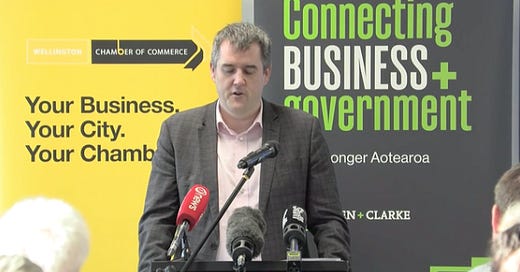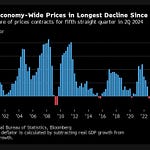TL;DR: Housing, Infrastructure and RMA Reform minister Minister Chris Bishop gave the new Government’s most important and ambitious speech of its first 100 days yesterday, pledging to flood cities with land for homes and help give councils new revenue to pay for the water and transport infrastructure needed to build on that land.
In the process, Bishop set the most substantial housing affordability goal by any Government in a decade, saying he wanted house-price-to-income multiples to more than halve to between 3-5 times income over the next ten to 20 years. The last National housing minister to set a house-price-to-income multiple goal of four times income was Nick Smith in April 20141, when Auckland’s ratio was seven. The internationally recognised2 median house price to median household income multiple was 6.6 nationally and 8.1 in Auckland at the end of January this year, down from peaks of 12.6 and 9.3 in September 2021.

In my view, Bishop’s speech to the Wellington Chamber of Commerce was the most encouraging by a housing minister since then-new-Housing Minister Megan Woods dumped Labour’s 100,000 Kiwibuild homes target in September 20193. It includes the potential for the most useful major infrastructure funding reform ever, but remains deeply flawed and unlikely to succeed without:
changing savings and tax incentives for home owners for both housing and pension saving;
ensuring the currently routine and massive land bankers’ re-zoning profits are mostly captured to subsidise infrastructure investment;
confirmation of massive capital grant and revenue help for councils to change their incentives; and
the reversal of the current opposition of supporters of National-ACT-NZ First to housing infrastructure investment and urban intensification.
Somehow, those land banks will have to actually be built on quickly with affordable apartments to improve overall house-buying and rental affordability. Also, councils and ratepayers will have to believe they benefit from investing in and maintaining the infrastructure, especially for much-more densified housing, public transport, walking and cycling infrastructure near city centres.
Bishop’s grand ambition and strategy has yet to have a fleshed-out with series of actions and agreements on key flash points such as sharing GST, value capture and congestion and water charges. Bishop has said he will present a more detailed set of actions to Cabinet by the end of March. That will be when the rubber in his speech will have to hit the road towards housing affordability.
(Paid subscribers can see more detail from Bishop and my analysis of the speech and his cabinet paper below the paywall fold and in the podcast above. I’ll open it up for public reading, listening and sharing if we get over 100 likes.)
Elsewhere in the news in Aotearoa-NZ’s political economy at 10 am:
The Public Service Commission published its review of the Accredited Employer Work Visa Scheme (AEWV), finding Immigration NZ rushed through over 100,000 visas quickly to meet employer demand without enough checks, ignoring staff concerns about migrant exploitation, although some checks had since been tightened.
Immigration Minister Erica Stanford said she had asked for advice about the AEWV scheme “and immigration settings more broadly that I will be considering over the coming weeks.” She later told reporters in Parliament (RNZ Liu Chen) she wanted to strengthen some of the scheme’s settings “and I will be taking it to Cabinet in the next couple of weeks.” She has previous said she wanted to lift the skill levels of those bought in through the scheme, whereby construction workers, cleaners and truck drivers were three of the most used categories. (See more below in Charts of the day)
Finance Minister Nicola Willis told NZ Herald-$$$’s Jenee Tibshraeny the Government was looking at exempting some trusts from paying the new 39% tax rate. Deloitte partner Robyn Walker said this could involve applying the 39% to higher-income earning trusts, leaving lower-income trusts at the current 33%.
The most ambitious housing speech in a decade
‘Housing Minister’ has become something of a tombstone job in the last decade. It’s where high-fliers with ambition go to have their political careers ground into the dirt of Aotearoa-NZ’s most wicked policy problem, before they are cast aside and either sent back home or to the back-benches.
Chris Bishop is no doubt sure he can be the exception that proves the rule and he has come out all guns blazing in his first substantial speech on housing, which is the most encouraging thing I’ve seen to come out of the Government in its first 100 days.
He gave the most vivid description of the problem I’ve seen from a politician since Phil Twyford was in opposition. Here’s a selection of his key quotes (bolding mine):
Our collective failure to build enough houses has trapped people in poverty, it has increased inequality, it has made us poorer rather than wealthier, and it has shattered the Kiwi dream of a property-owning democracy.
At its heart I believe housing is a moral issue.
How can anyone look at the mother forced to go into labour in a car in Rotorua and think that is kind or moral? How is it moral for thousands of our fellow citizens to live in motels for months at a time, bouncing from grotty unit to unit, often surrounded by squalor, crime and poverty?
This is state neglect on an industrial scale. And it is entirely self-inflicted and unnecessary. What sort of country have we become where this becomes institutionalised and normalised?
The simple truth is that young people today just don’t have the same opportunity to get into the housing market as their parents did, or their grandparents.
Fundamentally it is an issue of intergenerational equity. Young people stare at our broken housing market and think they have no hope of ever owning their own home. And for many, they’re right. They don’t.
Are we surprised that so many are leaving New Zealand? Most of my friends live offshore. The lure of London, New York and Sydney will always be attractive to young Kiwis.
But our housing market is practically standing at the departure lounge at Auckland Airport and in big neon writing telling them to just get on the plane.
And the housing market is the giant sucking sound at the heart of the New Zealand economy telling them not to bother coming home. Chris Bishop speech to the Wellington Chamber of Commerce yesterday.
He laid out an agenda of ‘five interlocking actions’:
First, our Going for Housing Growth policy will smash urban limits holding our cities back, fix infrastructure funding and financing, and introduce incentives to encourage cities and regions to go for growth.
Second, improvements to the rental market will make it easier to be a landlord, and easier to be a tenant.
Third, building and construction changes will improve competition and lower building costs.
Fourth, better social housing will better look after those who need support.
Fifth, reform of the Resource Management Act. Chris Bishop
Can Bishop side-step and swamp the land-bankers?
Bishop’s main strategy is to flood the housing market with land that can be built on and to ensure councils provide the infrastructure and zoning to ensure that happens.
The missing link in my view is the incentive for developers and investors to quickly build and ‘flood the zone’ with homes aimed at renters and first home buyers, and to avoid the scourges of the last great housing land supply push — Nick Smith’s ill-fated Special Housing Areas (SHAs) — which was land-banking and a lack of infrastructure investment followthrough from councils hitting debt limits.
Smith believed simply fast-tracking the zoning of greenfields and brownfields land would be enough unlock a supply shock that drove down prices and rents, at least after inflation. Instead, land buyers simply captured the massive capital gains from rezoning land and then drip-fed the land out to ensure prices didn’t fall, and almost all of the houses that were built were not affordable. Although much of it was ‘live’ zoned for housing, it often came with a caveat that developers had to front up with massive development contributions to pay for water and roading infrastructure. Either the councils baulked because the contributions were not enough, or the developers chose to sit on their hands with the home a new central Government would front up the capital.
Four years after SHAs were launched in October 2013, just 68 of the 3,157 homes built in 154 SHAs in Auckland were affordable homes for sale to private first-home buyers. RNZ Todd Niall A 2018 Auckland study found “the creation of the SHA generated an average price increase of approximately 5%, and more generally that affordability did not improve, but rather worsened.”
The vast majority of houses built on SHA land were the usual large homes costing over $1 million that were aimed at those nearing retirement. This market is the one the private housebuilding sector is attuned to, given older equity-rich buyers are the only ones able to afford large multi-bedroom-and-garage homes, which developers deem the only ones with high-enough profit margins to justify the risk and pay for escalating development contributions.
The other major complaint with the SHAs was that councils were forced to zone the land for housing, but would not or could not invest in the water and transport infrastructure to support housebuilding, especially on greenfields land where brand new pipes and roads need building and development contributions do not cover the costs.
Zoning for extra housing does work, just not as well as it should
But even with the land-banking and infrastructure shortages, up-zoning to increase housing supply does improve affordability for home-buyers and renters, as was evident during the natural experiments of the post-quake rebuilds in Christchurch, when the central Government subsidised infrastructure, the post 2016 Auckland Unitary Plan partial upzoning (aside from Ponsonby, Remuera, Mt Eden and Parnell) and the post 2019 Lower Hutt upzoning.
Sadly, the argument put foward that upzoning doesn’t work because of land-banking and the reluctance of private developers to drive down prices by flooding their own markets, was picked up by the Independent Hearings Panel for Wellington City Council’s recent changes and used to actually justify downzoning. Interestingly in the speech, Bishop said he would be the final decisionmaker on the now-widely-derided plan.
The idea that zoning and land supply does not affect housing affordability is frankly nuts. The evidence is as plain as day: cities that make it difficult to build more housing have housing affordability problems. Cities that legalise housing find it is more affordable.
I can also announce today that I will be the decision-maker on relevant district plan changes relating to housing where councils and Independent Hearings Panels do not agree – for example, the Wellington IHP process depending on where the Wellington City Council lands on it, or any requests for extensions to timeframes – in my role as the Minister Responsible for RMA Reform. Chris Bishop speech.
Rightly, and in contrast to Nick Smith’s initial approach, Bishop acknowledged the central Government couldn’t simply force councils to zone for housing without helping them with funding for infrastructure.
Zoning more land by itself isn’t enough. The plain fact is that Councils need new tools to fund infrastructure.
Currently, local roads and water infrastructure compete with other Council services for funding. For Councils at or near their debt limit, new infrastructure is necessarily funded from working capital, putting upwards pressure on water charges or rates and forcing Councils to depend on hand-outs from the central government through programmes like the Infrastructure Acceleration Fund set up by the previous government.
Our position is that pricing should play a greater role in infrastructure funding. Growth bottlenecks have emerged precisely where prices do not reflect costs. Infrastructure should earn sufficient lifetime revenue from service charges to recover its whole-of-life costs. Where charges are credibly signalled in advance, they will be reflected in urban land prices by lowering the price a developer is prepared to pay for land.
Show me the money from value capture, congestion and water charges
Bishop is talking here about congestion charges, water charges and value capture, measures which both central Governments and councils have baulked at so far because voters don’t like ‘user pays’ and donors developers don’t like their untaxed capital gains on land values being ‘captured’ by anyone else — especially a council or the Government.
But at least Bishop is talking about it and ACT’s idea of sharing GST is still in the mix. We’ll see whether Treasury allow it anywhere near a Cabinet meeting for approval.
Too many Councils see housing as a burden, not a benefit. We aim to change that. Abundant housing benefits everyone, but too many councils are either ambivalent about growth or actively hostile to it. I want to shift the dial away from that so that councils and communities share in the benefits of growth.
In the coming months we will be looking at the best mechanism to give effect to our “Build for Growth” policy, where Councils gain a financial windfall from new housing. ACT campaigned strongly on sharing a percentage of the GST of new housing with councils. That will be part of the mix as we ponder how to get the incentives right. Bishop in the speech.
Going further with a house-price-to-income commitment
Bishop then went further in this RNZ Checkpoint interview last night by stating a preference for an eventual affordability target of 3-5 times income within 10-20 years.
Asked if he wanted house prices to fall, he said a crash "tomorrow" would "cause enormous economic and financial instability to people".
"What I want is for house prices to moderate over time, so that in 10 to 20 years' time, we have essentially gone a long way towards solving our housing affordability problem.
"In housing markets that we consider to be affordable, a house price to income ratio of between three and five is considered affordable. That's not the case in most of our major cities right now."
"Over time as you moderate house prices and incomes grow, [three to five] is what we would like to see things get to, but as I say, that is not going to happen immediately and it is not going to even happen in the next two to three or four years. This is something that has to happen in the medium- to long-term.
"And unless we do that, house prices will continue to go up and people will continue to be locked out of the housing market.
"I want house prices to be affordable, and a house price to income ratio of seven, eight, nine, 10, 11, 12, in some cases 13 to one in some parts of New Zealand is not affordable, entrenching inequality and poverty in our cities." Bishop via RNZ Checkpoint
He refused to give an exact timeframe, saying he wouldn’t repeat Labour’s ‘100,000 homes’ mistake, but did gave some indication:
"What I want is for house prices to moderate over time, so that in 10 to 20 years' time, we have essentially gone a long way towards solving our housing affordability problem." Bishop via RNZ Checkpoint
But is cutting the multiple to 3-5 from 6-8 even possible in 20 years?
In short, a combination of very fast income growth and flat-to-falling nominal house prices would make an ‘automatic moderation’ towards a multiple of 3-5 possible. This chart via Interest showing the fall from a November 2021 peak of 12.6 and 9.3 respectively for Auckland and New Zealand to 8.1 and 6.6 now shows it is possible. The 5-10% rise in household incomes in the last couple of years as house prices fell around 20% was enough to do the trick. Flat prices with 5%-plus income growth would drive the multiple there over 20 years

A land tax and pension saving tax breaks are still needed
In my view, the true test of the supply-shock argument comes when the tax incentives for land buying and housebuilding change for home owners, landbankers, housebuilders and councils.
Currently, the lack of a capital gains tax and the lack of tax breaks for saving in pension funds to invest in businesses means home owners and landbankers are incentivised to buy and hold land after leveraging it up with bank loans, comfortable in the knowledge land prices always escalate and are eventually liquid.
In my view, a 0.5% annual tax on occupied residential-zoned land values and a 1.5% tax on unoccupied (both built and unbuilt) residential-zoned land values to pay for infrastructure would change the incentives for land banking and shift the land price inflation expectations permanently lower. Some form of incentive to save in pension funds would completely flip the incentives and encourage investment in housebuilding and other real business IP, training and technology.
In the spirit of The Kākā Project, a ‘full court press’ to change incentives would include:
land tax on residential land values, and land-bankers in particular;
pension savings tax break;
water and public infrastructure paid for with Treasury bonds serviced by land tax, congestion charges, water charges and land uplift value capture revenues;
the reversion of interest deductibility and ‘bright-line’ house trading income rules to previous rules; and,
a proper carbon tax and taxes on nitrous oxide and methane emissions to pay for emissions-reducing and water-quality-improving infrastructure.
Charts of the day
Very skilled cleaners and truck drivers

Cartoon of the day
100 days of targets
Timeline cleansing nature pic
Dive right in
Ka kite ano
Bernard
Then National Housing Minister (now Nelson Mayor Nick Smith) set the four times income aim in an interview on TVNZ’s Q&A on April 13, 2014. Scoop
Interest.co.nz regularly publishes the internationally recognised measures of House Price to Income multiples here.
















Share this post